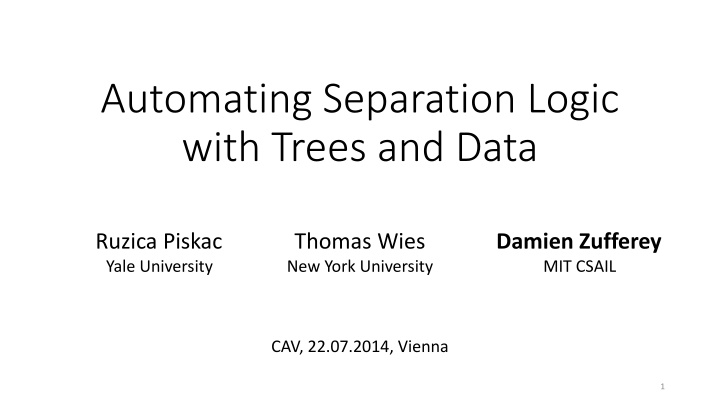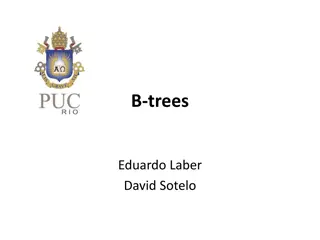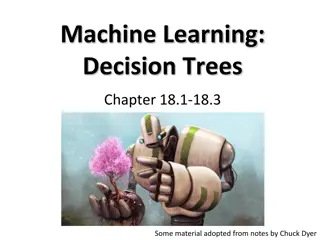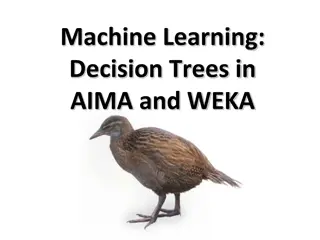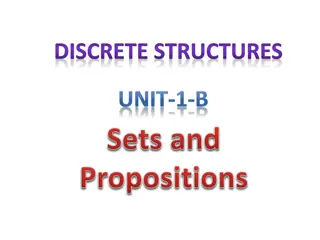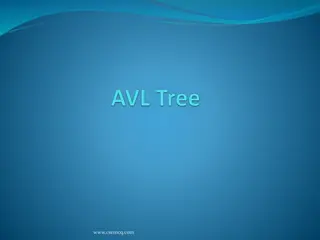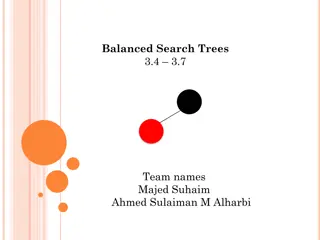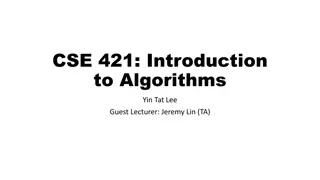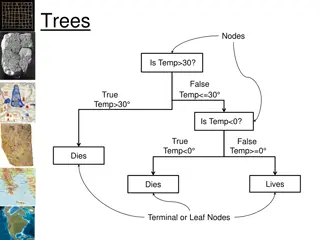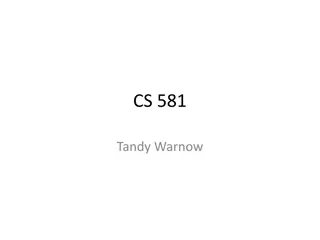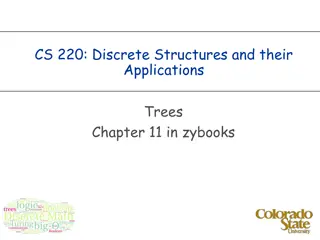Automating Separation Logic with Trees and Data
This content discusses the automation of separation logic using trees and data, focusing on extracting the maximum element in a Binary Search Tree (BST). It covers the motivation behind the procedure for extracting the max element, memory safety considerations, functional correctness, and preserving the shape of trees. The content also touches on trees in separation logic, separating conjunction, and other aspects of working with allocated access in computational procedures.
Download Presentation

Please find below an Image/Link to download the presentation.
The content on the website is provided AS IS for your information and personal use only. It may not be sold, licensed, or shared on other websites without obtaining consent from the author.If you encounter any issues during the download, it is possible that the publisher has removed the file from their server.
You are allowed to download the files provided on this website for personal or commercial use, subject to the condition that they are used lawfully. All files are the property of their respective owners.
The content on the website is provided AS IS for your information and personal use only. It may not be sold, licensed, or shared on other websites without obtaining consent from the author.
E N D
Presentation Transcript
Automating Separation Logic with Trees and Data Ruzica Piskac Yale University Thomas Wies New York University Damien Zufferey MIT CSAIL CAV, 22.07.2014, Vienna 1
Motivation: extracting max element in a BST procedure extract_max(root: Node, pr: Node) returns (new_root: Node, max: Node) { var c, m: Node; if (root.right != null) { c, m := extract_max(root.right, root); root.right := c; return root, m; } else { c := root.left; root.parent := null; if (c != null) c.parent := pr; return c, root; }} 0 6 0 6 2
Motivation: extracting max element in a BST procedure extract_max(root: Node, pr: Node) returns (new_root: Node, max: Node) { var c, m: Node; if (root.right != null) { c, m := extract_max(root.right, root); root.right := c; return root, m; } else { c := root.left; root.parent := null; if (c != null) c.parent := pr; return c, root; }} p r m 3
Motivation: extracting max element in a BST procedure extract_max(root: Node, pr: Node) returns (new_root: Node, max: Node) { var c, m: Node; if (root.right != null) { c, m := extract_max(root.right, root); root.right := c; return root, m; } else { c := root.left; root.parent := null; if (c != null) c.parent := pr; return c, root; }} p r 4
Motivation: extracting max element in a BST procedure extract_max(root: Node, pr: Node) returns (new_root: Node, max: Node) { var c, m: Node; if (root.right != null) { c, m := extract_max(root.right, root); root.right := c; return root, m; } else { c := root.left; root.parent := null; if (c != null) c.parent := pr; return c, root; }} Memory safety Preserve shape of trees Functional correctness Preserve frame 0 6 5
Trees in SL ???? ? ? = ???? ??? ? ???? ?.? ????(?.?) Separating conjunction Allocated (access) x l r 6
Motivation: extracting max element in a BST procedure extract_max(root: Node, pr: Node) returns (new_root: Node, max: Node) Non-empty binary search tree requires bst(root, pr) * root null; ensures bst(new_root, pr) * acc(max); Binary search tree and a single node ensures max.right = null max.parent = null; { } 7
Motivation: extracting max element in a BST procedure extract_max(root: Node, pr: Node, implicitghost content: Set<Int>) returns (new_root: Node, max: Node) requires bst(root, pr, content) * root null; ensures bst(new_root, pr, content / {max.data}) * acc(max); ensures max.right = null max.parent = null max.data content; ensures z (content / {max.data}). z < max.data; { } 8
Existing approaches to reasoning about SL with trees Unrolling inductive definitions [Nguyen et al. 07, Qiu et al. 13] Advantages: conceptually simple and efficient Limitation: incompleteness Reduction to MSOL [Iosif et al. 13] Advantage: complete Limitations: high complexity, non trivial extensions with data Other approaches not targeting SL Limitations: global assumptions about structure of the heap 9
Limitation of unfolding based methods procedure contains(root: Node, val: Int) returns (res: Bool) requires tree(root); ensures tree(root); { var curr: Node := root; while (curr != null && curr.data != val) invariant ???; { if (curr.data < val) { curr := curr.left; } elseif (curr.data > val) { curr := curr.right; } } if (curr != null) return true; elsereturn false; } root curr 10
Contributions A decision procedure for a fragment of SL with trees and data Complete Low complexity (NP-complete) SMT-based (allows for combination with other theories) Implemented in the GRASShopper tool Functional correctness of tree based data structure 11
Limitation of unfolding based methods procedure contains(root: Node, val: Int) returns (res: Bool) requires tree(root); ensures tree(root); { var curr: Node := root; while (curr != null && curr.data != val) invariant tree(curr) -** tree(root); { if (curr.data < val) { curr := curr.left; } elseif (curr.data > val) { curr := curr.right; } } if (curr != null) return true; elsereturn false; } root Russian dolls operator curr 12
SL to First Order Logic [Piskac et al. 13] precise fragment formula SL decidable fragment structure footprint FOL reachability sets For entailment queries: negate only We provide a target logic, called GRIT, for SL of trees 14
Example of the Translation ???? ????,?? ??? ??? (???.? = ???? ???.? = ????) ???? ?,????,??,?,?,? ???.? = ???? ???.? = ???? ?1 ?2= ?1 ?3= ?2 ?3= ? = ?1 ?2 ?3 ?. ? ?1 ? ?,?,???? ?2= {max} ?3= 15
Backward Reachability t1 t1 r p l p (l,r)* p* l r r p l p p p t2 t2 Reasoning using backward reachability [Balaban et al. 07] Allows us to use work on reachability logics [Rakamaric et al. 07, Lahiri & Qadeer 08] Axiomatization of Tree in terms of reachability predicates, based on [Wies et al. 11] 17
Axioms: definition of the footprint ?. ? ? ?(?,?,????) root null p* x 18
Axioms: p inverse of l ? ?. ?.? = ???? ? ?,?.?,? x l p* null 19
Axioms: l and r descendants ?,?.? ? ? ?,?,? ? = ? ? ?,?,?.?,? ? ?,?,?.?,? y y y l r x,y p* p* p* x x x 20
Underlying Principle Based on local theory extensions [Sofronie-Stokkermans, CADE 05] Reasoning done on partial models p* p l,r 21
Monadic predicates ?. ? ? ?(?.?) , e.g., lower and upper bounds Already local, therefore fits into GRIT decision procedure 3 Apply the axioms to each term in the formula 3 2 2 1 1 23
Binary predicates Needs to be transitive (generalize to reachability) Sorted trees are ok Trees with height are not 2 0 1 3 Reasoning on partial model 0 3 24
Set projection The content of a tree: C = ? ? ?. ?.? = ? } Introduce a ???????(?,?,?) Skolem fct with a local axiomatization C = 0,2,3 ???????(?,2,?) 2 null ???????(?,1,?) ???????(?,3,?) 0 3 ???????(?,0,?) 25
Experiments GRASShopper https://cs.nyu.edu/wies/software/grasshopper/ Tested on tree data structures: binary search trees skew heaps union-find (inverted trees) Show memory safety and functional correctness for basic operations Operations: from 8 to 77 LOC, spec from 3 to 7 lines Solving time: median=3s, average = 33s, max = 361s Detailed results in the paper 26
Contributions In this paper, we introduced: An NP-decision procedure for a fragment of SL with trees and data SMT-based decision procedure allows for combination with other theories Implemented in the GRASShopper tool https://cs.nyu.edu/wies/software/grasshopper/ 27
Related Work SL inductive definitions of bounded tree-width [Iosif et al. 13] MSOL [Thatcher & Wright 68, Klarlund & M ller 01] Reachability and data: [Bouajjani et al. 09, Madhusudan et al. 11] Tools for proving functional correctness of linked data structures: Bedrock [Chlipala 13], Dafny [Leino 13], Jahob [Zee et al. 08], HIP/SLEEK [Nguyen et al. 07], and VeriFast [Jacobs et al. 11]. 28
Axioms: no non-trivial cycles ?,? ?. ? ?,?,? ? ?,?,? ? = ? x x,y p* y 29
Axioms: nothing between parent and child ? ?,?. ? ?,?.?,?,? ? = ? y = ?.? x x x,y p* l l p* l p* y y 30
Axioms: children distinct ? ?. ?.? = ?.? ?.? = ???? ? ?. ?.? ? ?.? ? x l,r l,r x null 31
First Common Ancestor fca(p,x,y) x y x y Needed to make sure we can build trees from partial models 32
GRASShopper: experimental results 1 Data structure Procedure # LOC # L spec # L ghost #VCs Time in s Contains 17 3 3 9 3 Destroy 8 2 2 7 1 Set as binary tree Functional correctness Extract_max 14 5 3 9 20 Insert 24 2 3 15 61 Remove 33 2 11 35 117 Rotate (l,r) 8 3 4 11 15 Contains 15 7 6 4 1 Delete 26 7 6 8 12 Set as sorted list Functional correctness Difference 20 3 1 15 13 Insert 25 7 6 8 69 Union 20 3 1 15 15 33
GRASShopper: experimental results 2 Data structure Procedure # LOC # L spec # L ghost #VCs Time in s Find 12 2 1 4 0.2 Union-find (tree view) Functional correctness Union 10 3 1 4 0.3 Create 11 3 0 3 0.1 Find 12 3 1 4 0.1 Union-find (list view) Path compression Union 9 7 1 4 3 Create 10 1 0 3 0.1 Insert 17 2 2 7 0.3 Skew heap Shape, heap property Union 11 2 4 12 35 Extract_max 9 2 1 11 6 And some more examples using loops 34
Axiomatization of GRIT ?,? ?. ? ?,?,? ? ?,?,? ? = ? ? ?. ?.? = ???? ? ?,?.?,? ? ?,?. ? ?,?.?,?,? ? = ? y = ?.? ? ?. ?.? = ???? ? ?,?.?,? ? ?,?. ? ?,?.?,?,? ? = ? y = ?.? ?,?.? ? ? ?,?,? ? = ? ? ?,?,?.?,? ? ?,?,?.?,? ? ?. ?.? = ?.? ?.? = ???? ? ?. ?.? ? ?.? ?.? ?. ? ? ?(?,?,????) 35
First-Order Axioms for B(etween) f x. B(f, x, x, x) f x. B(f,x, x.f, x.f) f x y. B(f, x, y, y) x = y B(f, x, x.f, y) f x y. x.f = x Btwn(f,x,y,y) x = y f x y. B(f, x, y, x) x = y f x y z. B(f,x,y,y) B(f,y,z,z) B(f,x,y,z) B(f,x,z,y) f x y z. B(f,x,y,z) B(f,x,y,y) B(f,y,z,z) f x y z. B(f,x,y,y) B(f,y,z,z) B(f,x,z,z) f x y z u. B(f,x,y,z) B(f,y,u,z) B(f,x,u,z) B(f,x,y,u) f x y z u. B(f,x,y,z) B(f,x,u,y) B(f,x,u,z) B(f,y,u,z) 36
Graph Reachability and Inverted Trees (GRIT) Graph reachability, stratified sets, and Tree predicates. ???? ?,?,?,?,? ?: footprint ?: root of the tree ?,?,?: left, right, parent fields ?(?,?,?): ? reaches ? by following ?. ?(?,?,?,?): ? is in the ?-path between ? and ?. Semantics of ???? ?,?,?,?,? axiomatization in terms of R,B. based on [Wies et al. 11]. 37
Motivation for SMT-based SL reasoning Frontend / Specification Backend / Solver - tailor-made solvers - difficult to extend + local reasoning (frame inference) + succinct + intuitive SL + flexible - complex + standardized solvers (SMT-LIB) + extensible (e.g. Nelson-Oppen) FOL Strong theoretical guarantees: sound, complete, tractable complexity (NP) Mixed specs: escape hatch when SL is not suitable. 38
